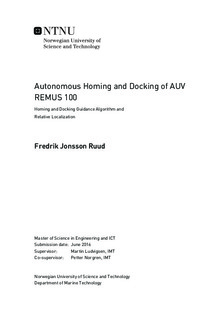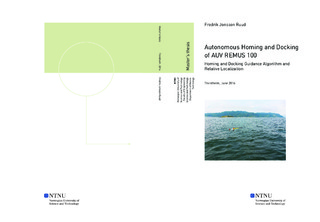| dc.description.abstract | This master's thesis presents an algorithm for homing and docking of NTNU's AUV, REMUS 100. Such an algorithm would ease the retrieval of the AUV and facilitate for future underwater docking missions. The homing phase of the algorithm steers the AUV safely close to the docking station where the docking phase takes over until the AUV is successfully docked. After docking, communication can be established and batteries charged, while the AUV is securely held in place. For this to happen, the algorithm needs to be complex and address guidance, navigation and control systems.
The Digital Ultra-short Baseline (DUSBL) and Long Baseline (LBL) acoustic positioning systems are both considered for the homing and docking task. Only one transponder is used in the acoustic system, namely the one mounted on the docking station. This motivated to create a particle filter for position estimation from range-only LBL measurements.
The REMUS 100 AUV simulator, AUVSim, was used to make all simulations. AUVSim was extended with a homing/docking block that could simulate LBL/DUSBL measurements, as well as the homing and docking algorithm.
Results from simulations show that the DUSBL sensor with the proposed algorithm is suitable for autonomous homing and docking. Simulations also showed that a particle filter which used range-only data from the LBL sensor was able to dock successfully. A mission conducted on Trondheimsfjorden June 2, 2016, made clear that the acoustic ping rate and LBL settings need modifications before LBL docking is possible in real life. The ping rates were too low and the LBL sensor did not get any measurements close to the transponder. LBL homing was still possible in AUVSim when adjusting the simulations to the real ping rates. | |

